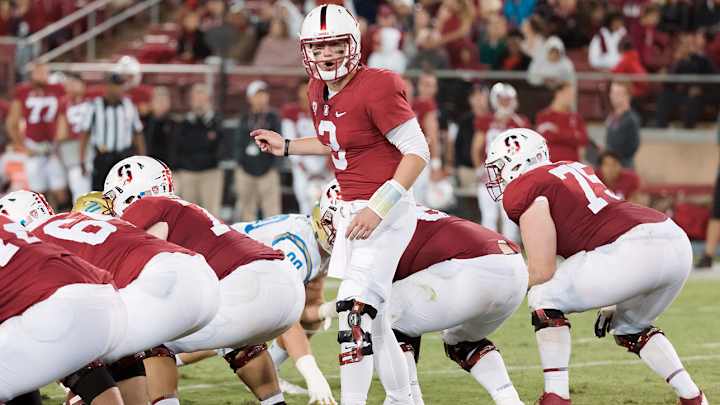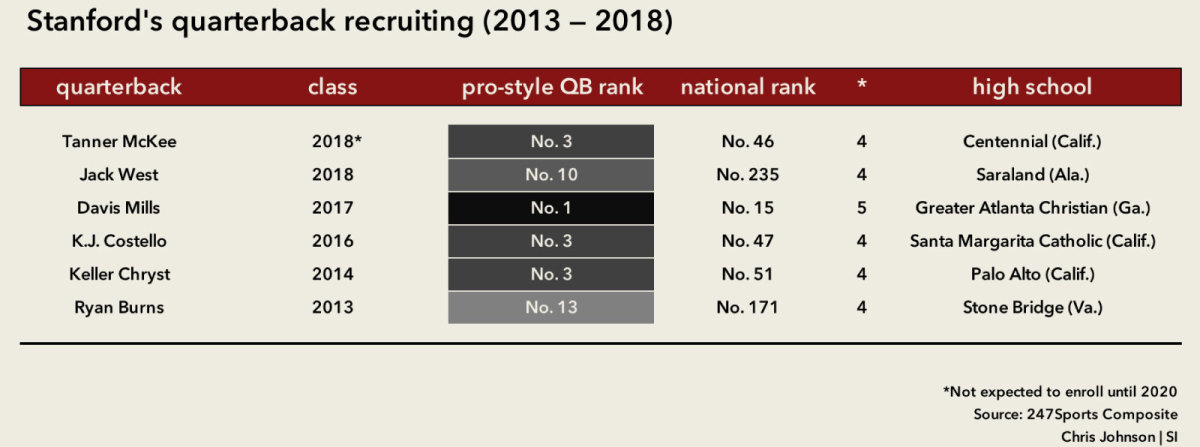Stanford Has Built a Pro-Style QB Pipeline in Andrew Luck's Wake

In the run-up to National Signing Day this year, there wasn’t much to look forward to at the position with the most influence on a team’s fortunes. Just about every elite quarterback in the class of 2018 had already announced where he was going to school. The only one who hadn’t was Tanner McKee, a 6'6", 220-pound standout at Centennial High in Corona, Calif., favored to choose Stanford during a televised announcement ceremony. McKee didn’t buck expectations, unzipping a black jacket to reveal a Stanford T-shirt before slipping on a black baseball cap bearing the university’s block “S” logo.
McKee, who chose the Cardinal over finalists Alabama, Texas, Texas A&M and Washington, was a big get for Stanford. As a senior at Centennial, he passed for 2,147 yards with 23 touchdowns against just two interceptions, rushed for 675 yards on 11.4 yards per carry and was rated the No. 3 pro-style quarterback and No. 46 overall player in the country, according to the 247Sports Composite. “Makes every different type of throw asked of our guys,” offensive coordinator and quarterbacks coach Tavita Pritchard said of McKee, adding that he “runs the ball better than you think he might at his size.”
McKee’s recruitment differs from those of other signal-callers who signed National Letters of Intent on Feb. 7 in one crucial respect. As a member of the Church of Jesus Christ of Latter-day Saints (LDS), McKee won’t be available to suit up for the Cardinal until 2020 because he plans to serve a two-year mission. But Stanford will have a new quarterback to show off this year even without McKee. As part of its 14-man class, the Cardinal also brought in Saraland (Ala.) High’s Jack West, the No. 10 pro-style QB in the country.
The additions of McKee and West extended Stanford’s dominant run recruiting pro-style quarterbacks in the post-Andrew Luck era. The Cardinal have used their six classes since the two-time Heisman Trophy finalist and two-time Pac-12 Offensive Player of the Year was picked first overall in the 2012 NFL draft to hoard pocket-passing blue chippers who can excel in their pro-style system. From ’13 to ’18, Stanford signed six quarterbacks classified as pro-style and assessed ratings of four stars or higher by 247Sports.
That group of six QBs includes McKee, of whom it’s more useful to think as a class of 2020 prospect because of the two-year delay in his enrollment. Four of the six were rated third or better among the pro-style signal callers in their respective classes; the two others are West (10th in 2018) and Stone Bridge (Va.) High’s Ryan Burns (13th in 2013). In only one year during that span, 2015, did Stanford not sign a quarterback, which head coach David Shaw explained was a forward-looking decision. “I wanted to take a gap year and concentrate on the 2016 class,” Shaw said, according to The Mercury News.
A couple of those QBs will have left Stanford by the start of next season. Burns’s eligibility expired in 2017, and the quarterback who signed with the Cardinal one year after Burns, Palo Alto (Calif.) High’s Keller Chryst, announced on Thursday that he will transfer to Tennessee as a graduate student with immediate eligibility. Stanford’s 2016 quarterback signee, Santa Margarita Catholic (Calif.) High’s K.J. Costello, projects as a breakout candidate as a redshirt sophomore this fall after supplanting Chryst as the starter midway through last season.
Stanford’s recent track record reeling in pro-style quarterbacks might lead one to expect that the Cardinal have a heated battle for QB1 status ahead in the coming weeks. Quite the opposite, actually. Sports Illustrated’s Bruce Feldman reported earlier this month that Costello is expected to sit out the spring because of a hip injury, and Stanford’s only other returning scholarship QB, Greater Atlanta Christian (Ga.) School’s Davis Mills, who was rated the No. 1 pro-style passer in the class of 2017, will also be sidelined while recovering from an ACL injury.

Over the course of this decade, Stanford has become a dream destination for quarterbacks looking for rigorous academics, a balmy climate and near-annual contention for conference championships and big-time bowl games. Yet Stanford also distinguishes itself from other programs courting top-end signal callers with its offensive scheme. As spread concepts have permeated the highest level of college football and begun creeping into the NFL, the Cardinal have not wavered from their identity as a smashmouth pro-style powerhouse that wins by imposing their “intellectual brutality” on the opposition.
Stanford’s offensive scheme has enhanced its appeal to quarterbacks (and other recruits) for the simple reason that it has helped the Cardinal pile up a lot of Ws, but it also serves as an enticement to QBs for the way it can advance their professional aspirations. Making due allowance for the NFL’s increasing embrace of college principles, Stanford’s pro-style tenets can endear signal callers to talent evaluators looking for quarterbacks who won’t face a steep learning curve at the next level. After all, it’s been less than three years since The Wall Street Journalreported about the league’s “quarterback crisis,” owing to “QB prospects entering the league without the skill sets to excel.”
Consider Kevin Hogan, a former three-star recruit who went on amass 10,634 total yards and post a 36–10 record over four years as Stanford’s starter before being selected by the Kansas City Chiefs in the fifth round of the 2016 draft. (Hogan was cut and subsequently joined the Cleveland Browns.) “Perhaps the buzziest draft phrase relating to quarterback evaluations is ‘NFL ready’—a reference to the intangible measurement of how quickly a college prospect can adapt,” NFL draft analyst Chris Burke wrote for SI.com in March of 2016. “In this category, Hogan is near the top of his class.”
In a recent interview, Greg Biggins, a national recruiting analyst for 247Sports based in southern California, endeavored to describe the thought process of a hypothetical pro-style QB recruit who elects to spend his college years on The Farm. “With Stanford,” Biggins said, “I think you feel like, ‘If I’m a pro-style quarterback, I want to make the NFL and I have great grades—that’s my number one choice. What better place to go than to Stanford?’”
To be sure, there are other programs running schemes attractive to quarterbacks who fit the pro-style label. Clemson, for example, signed the No. 1 pro-style QB recruit (and No. 1 player overall) in this year’s class, Cartersville (Ga.) High’s Trevor Lawrence, in addition to the No. 2 pro-style QB recruit in last year’s class, Brownsburg (Ind.) High’s Hunter Johnson. And USC, one of the Cardinal’s top challengers in the Pac-12, is set to bring in Mater Dei (Calif.) High five-star JT Daniels, who left no doubt that he wanted to play in a pro-style attack before announcing his reclassification from 2019 to 2018 last December.
Not every top-end pro-style QB Stanford pursues will prefer the Cardinal to other options, and not every top-end pro-style QB who chooses them will live up to his recruiting pedigree, but Stanford’s 2018 cycle reinforced the strength of the pitch that Shaw and his staff can make to that type of passer, one that should continue to carry a lot of weight as long as the Cardinal remain a force in the Pac-12 North. In McKee and West, Stanford is adding two promising quarterbacks, two years apart, whose skill sets align with an already deep pool of players at that position.
